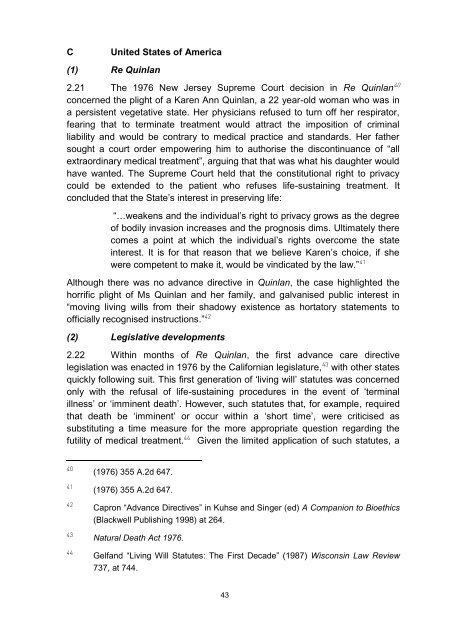Consultation Paper on Bioethics - Law Reform Commission
Consultation Paper on Bioethics - Law Reform Commission
Consultation Paper on Bioethics - Law Reform Commission
Create successful ePaper yourself
Turn your PDF publications into a flip-book with our unique Google optimized e-Paper software.
C United States of America<br />
(1) Re Quinlan<br />
2.21 The 1976 New Jersey Supreme Court decisi<strong>on</strong> in Re Quinlan 40<br />
c<strong>on</strong>cerned the plight of a Karen Ann Quinlan, a 22 year-old woman who was in<br />
a persistent vegetative state. Her physicians refused to turn off her respirator,<br />
fearing that to terminate treatment would attract the impositi<strong>on</strong> of criminal<br />
liability and would be c<strong>on</strong>trary to medical practice and standards. Her father<br />
sought a court order empowering him to authorise the disc<strong>on</strong>tinuance of “all<br />
extraordinary medical treatment”, arguing that that was what his daughter would<br />
have wanted. The Supreme Court held that the c<strong>on</strong>stituti<strong>on</strong>al right to privacy<br />
could be extended to the patient who refuses life-sustaining treatment. It<br />
c<strong>on</strong>cluded that the State‟s interest in preserving life:<br />
“…weakens and the individual‟s right to privacy grows as the degree<br />
of bodily invasi<strong>on</strong> increases and the prognosis dims. Ultimately there<br />
comes a point at which the individual‟s rights overcome the state<br />
interest. It is for that reas<strong>on</strong> that we believe Karen‟s choice, if she<br />
were competent to make it, would be vindicated by the law.” 41<br />
Although there was no advance directive in Quinlan, the case highlighted the<br />
horrific plight of Ms Quinlan and her family, and galvanised public interest in<br />
“moving living wills from their shadowy existence as hortatory statements to<br />
officially recognised instructi<strong>on</strong>s.” 42<br />
(2) Legislative developments<br />
2.22 Within m<strong>on</strong>ths of Re Quinlan, the first advance care directive<br />
legislati<strong>on</strong> was enacted in 1976 by the Californian legislature, 43 with other states<br />
quickly following suit. This first generati<strong>on</strong> of „living will‟ statutes was c<strong>on</strong>cerned<br />
<strong>on</strong>ly with the refusal of life-sustaining procedures in the event of „terminal<br />
illness‟ or „imminent death‟. However, such statutes that, for example, required<br />
that death be „imminent‟ or occur within a „short time‟, were criticised as<br />
substituting a time measure for the more appropriate questi<strong>on</strong> regarding the<br />
futility of medical treatment. 44 Given the limited applicati<strong>on</strong> of such statutes, a<br />
40 (1976) 355 A.2d 647.<br />
41 (1976) 355 A.2d 647.<br />
42 Capr<strong>on</strong> “Advance Directives” in Kuhse and Singer (ed) A Compani<strong>on</strong> to <strong>Bioethics</strong><br />
(Blackwell Publishing 1998) at 264.<br />
43 Natural Death Act 1976.<br />
44 Gelfand “Living Will Statutes: The First Decade” (1987) Wisc<strong>on</strong>sin <strong>Law</strong> Review<br />
737, at 744.<br />
43

















